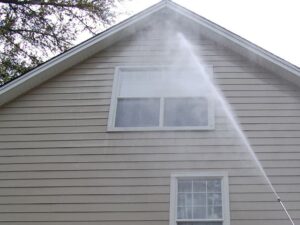As an Amazon Associate, this site earns commissions from qualifying purchases. For more information click here.
Knowing the difference between a 2-stroke and 4-stroke engine is a must for anyone who uses a gas pressure washer. The way you add fuel to a 2-stroke engine is different from a 4-stroke and making a mistake can damage the motor. If you are planning to buy a pressure washer or need to replace its fuel, you have to familiarize yourself with these engines.
Most pressure washers run on 4-stroke engines. The difference between the two is the number of fuel ports. A 2-stroke engine has one port while a 4-stroke has separate ports for oil and gas. You cannot mix oil and gas in a 4-stroke engine.
The term 2-stroke and 2-cycle are used interchangeably as is 4-cycle and 4-stroke. If you come across these words, just keep it mind it refers to the same things.
There are other ways to distinguish a 2-stroke from a 4-stroke engine. However, a quick overview of how these engines work is necessary.

How a 2-Stroke Engine Works
A 2-stroke engine requires two strokes per combustion cycle. The engine releases fuel after each cycle which in turn powers the pressure washer. The power and exhaust is called the downward stroke. The upward stroke refers to the compression and intake.
When the stroke is up, the piston goes from the cylinder bottom to the top, drawing fuel and air (intake). The fuel and air are compressed at the top (compression). As this occurs, the spark plug generates a combustion alongside the fuel and air mix.
The combustion pulls the piston down. As it does, a port opens where the remains of the combustion (exhaust) is ejected from the engine. In a 2-stroke pressure washer, two strokes are needed to ignite a combustion.
How a 4-Stroke Engine Works
A 4-stroke engine operates on the same principle as a 2-stroke, except it takes four strokes to complete a cycle. In a 2-stroke engine, the upward stroke consists of the intake and compression, and the downward stroke is comprised of the exhaust and power.
In a 4-stroke pressure washer, the intake, compression, exhaust and power all require separate strokes. But the basic process is the same. When the spark plug sets off a combustion, the crankshaft starts turning and the piston goes down.
The effect of the combustion is enough to make the piston go up and remove the exhaust. As the piston plunges into the cylinder, it intakes fuel. Then the cycle is repeated.
The Differences between 2-Stroke and 4-Stroke Pressure Washers
The biggest difference is that a 2-stroke requires one revolution per stroke while 4-stroke engine needs two revolutions. There are other ways to tell them apart however. Your owner’s manual will tell you if the engine is a two or four-stroke. In addition there are three things you can check.
Fuel
A 2-stroke pressure washer has a single port for gas and oil. You mix oil and gas with a 40:1 ratio, which is one gallon of gas for every 3.2 oz. of oil. Older 2-stroke engines require a 50:1 or 32:1 ratio. One of the most efficient pressure washers today is the 3400 PSI SIMPSON Cleaning CM61083 as it runs smoothly and efficiently.
A 4-stroke engine has separate filters for the gas and oil. You cannot combine the two. You must always pour the gas into the gas port and the oil into the oil port. The amount of fuel required varies so check with the manufacturer.
Efficiency
4-stroke pressure washers are more efficient in terms of waste management. A 4-stroke exhaust emits less smoke than a 2-stroke. Less gas is good for the environment and it is also more fuel efficient.
This is one of the reasons why most pressure washers today are 4-stroke. Not only is the engine greener, but it is healthier for the operator too. Nobody wants to use a pressure washer covered in smoke, which makes 4-cycle engines appealing.
Noise
4-stroke engines are quieter compared to a 2-stroke. A typical 2-stroke engine emits a loud sound with a high pitch. In contrast, a 4-stroke does not make as much noise. It is not completely silent but is less noisy.
If your neighborhood frowns upon loud engines, a 4-stroke pressure washer is the logical choice. Waking to the sound of a high pitched 2-stroke engine can be unpleasant, so opting for a quieter one is ideal. This is another reason why most pressure washers have gone 4-stroke. 4 stroke engines also make it easier to change the pressure on a pressure washer.
Which is Better: a 2-Stroke or 4-Stroke Pressure Washer?
A 4-stroke pressure washer is more efficient than a 2-stroke. It is quieter, more fuel efficient and lasts longer. It is also easier to find a 4-stroke pressure washer and all the major brands prefer it.
Both have their positives and drawbacks, but overall 4-stroke engines are better suited for residential use.
Availability. 4-stroke pressure washers are more widely available than 2-stroke. The top manufacturers mostly offer this engine. This also means spare parts for this motor are easier to find. If you are looking for convenience, 4-stroke is the better option. One that we can suggest is the Greenworks 1600 PSI pressure washer.
Longer lifespan. 4-stroke engines last longer, period. They are less vulnerable to wear and tear. If your pressure washer is going to be used heavily, it makes more sense to invest in a 4-stroke model. As pointed out earlier, their spare parts are more widely available. More to the point, you get more value from your money.
Less noise. This does not need any long explanation. Your neighbor will not be happy to hear a loud, whirring pressure washer, so it is prudent to get a quieter model. Even if you do not have any close neighbors, exposing your ears to loud noises regularly is not healthy.
The following is an overview of the pros and cons of both.
2-Stroke Advantages and Disadvantages
| 2-Stroke Pros | 2-Stroke Cons |
|---|---|
| Can run in hot and cold temperature | Noisy and vibrates |
| Simple design minimizes engine friction | Generates more smoke than a 4-stroke |
| Power to weight ratio is high | Consumes a lot of fuel |
| Smaller and lighter than a 4-stroke | May encounter problems when idle |
| Higher RPM compared to a 4-stroke | Fuel may leak out of the exhaust |
4-Stroke Advantages and Disadvantages
| 4-Stroke Pros | 4-Stroke Cons |
|---|---|
| Fuel efficient | More expensive than 2-stroke |
| More durable than a 2-stroke engine | Heavy |
| Runs quietly | More intricate parts could mean costly repair |
| No need to mix gas and oil | Needs regular maintenance |
| Higher torque compared to 2-stroke | Lower RPM |
Related Questions
Is it true that a 2-stroke engine is faster than a 4-stroke?
Yes, but speed is not important for pressure washers. The PSI and GPM are not affected by the speed so it is not a factor. A faster engine is not going to improve pressure washer performance, but the PSI and GPM will.
What if I put 2-stroke oil in a 4-stroke engine?
If you mix a small amount it might hamper performance, but will not damage the engine. But large amounts of gas and oil and you risk destroying the engine.
Can I use motor oil for my pressure washer?
No, motor oil is not compatible with most pressure washers. Use only the specific fuel type that the manufacturer recommends.
I added fuel to my pressure washer but it is leaking. Why?
There is probably too much in the tank or it was not sealed properly. The gasket might also need replacement. This article provides various solutions to this issue.
How long can I leave fuel in a 4-stroke pressure washer?
No more than 30 days. Replace the fuel after 30 days, otherwise it will turn gummy and be unusable. Empty the fuel tank if you are not going to be using the pressure washer for several weeks.
Why is 4-stroke pressure washer noisy?
This usually means there is a mechanical problem. Turn the machine off. Let the engine cool and inspect it. Check the spark plug, crankshaft, filters etc. Noise and vibration signifies potentially serious damage and requires servicing.

I love the outdoors and all the tools for maintaining gardens, yards and lawns. The only thing I am more passionate about is sharing what I know about garden and outdoor equipment.


